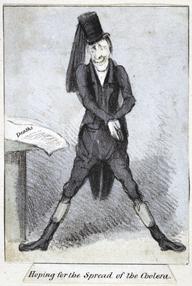





Portrait, photogravure, John Tyndall, made by Photographische Gesellschaft Berlin, 1910s, after a painting by John McLure Hamilton, 1893.
Tyndall was born in Ireland in 1820. He began his career there as a surveyor and later worked on land and railway surveys in Britain. In 1847 he started teaching mathematics at Queenwood College in Hampshire, which was one of the first schools in the UK equipped with a laboratory for teaching science. A year later, frustrated that he could not spend all his time conducting experiments, he decided to study at a German university, where he specialised in mathematics and magnetism. In 1853 he was appointed Professor of Natural Philosophy at the prestigious Royal Institution in London. There he turned his attention to geology and was particularly interested in the movement of alpine glaciers.
In the 1850s glaciology was a brand-new field of research. Tyndall was an experienced climber, and travelled quite often to the Alps to study its glaciers. Based on what was known at that time, together with his own observations, Tyndall became convinced that northern Europe had been covered with ice thousands of years ago. This made him wonder what might have caused ice ages and such a dramatic change of temperature. Tyndall knew about Joseph Fourier’s work and thought that the answer might be found in the composition of the atmosphere.
In 1859, Tyndall started to experiment to find out if gases in the atmosphere could trap heat energy. He did this in the basement laboratory of the Royal Institution, using an apparatus he had designed himself. Tyndall’s experiment showed that what we now called greenhouse gases, especially water vapour, dominate the absorption of heat energy in the atmosphere. He imagined that without water vapour in the atmosphere England would be ‘held fast in the iron grip of frost’. He suggested that changes in the amounts of atmospheric components could cause ‘all the mutations of climate which the researches of geologists reveal’.
At the time, Tyndall was trying to explain ice ages, and therefore only thought about what would happen if there were less of the greenhouse gases in the atmosphere. He did not consider the opposite situation – an increase in the concentration of greenhouse gases – and its consequences for the climate.
Details
- Category:
- Art
- Object Number:
- 1982-1459/71
- Materials:
- photogravure and paper
- Measurements:
-
overall: 327 mm x 465 mm
overall (image area): 185 mm x 248 mm
overall (plate mark): 252 mm x 300 mm




